| Introduction
Driver inattention is a well known and
widespread cause of accidents. Inattention to the road ahead takes many
forms, including:
-
mirror and speedo checks
-
looking at passengers
-
mind wandering
-
looking at and operating minor controls from
fog lights to stereo
-
problems arising from mobile telephones
-
poor concentration
-
failing to look properly
-
carelessness
It's quite obvious that a inattentive driver
will have a much greater overall stopping distance than one who is simply
travelling a few mph faster. You might think that no-one fails to pay attention
to the road ahead for 2.5 seconds, but consider this research published
by RoSPA (click
here) which contains the following alarming statistic on page 5:
-
Almost half (46%) of the inexperienced
drivers took their eyes off the road for more than 2.5 seconds, compared
with only 13% of experienced drivers.
From report: "How Long Does It Take to Stop?
Methodological Analysis of Driver Perception-Brake Times" by Marc Green,
2000 (Canada) we note that much research has put the "observation, understanding,
reaction and planning" phase at more than 1.5 seconds typically, although
it is also noted that greater danger tends to reduce the time taken. |
| A driver centric view
When accidents are considered, the "normal"
model is to place a vehicle at some number of miles per hour, and have
an object suddenly appear in front of the vehicle and ask if the vehicle
could be stopped in time. This is unlike any situation which normally occurs
on the road. For a start we haven't considered that the driver chose the
speed on the basis of the circumstances. We've denied the driver the opportunity
to anticipate the object moving into an obstructing position. And usually
we've placed the obstructing object in the worst possible position, and
the only possibility afforded is an emergency stop and (probably) a calculated
impact speed.
We want to change all that. We want to
account for the circumstances and allow our driver to set an appropriate
speed. We want to give the driver the chance to observe the obstructing
object and the chance to react to it. But then we want to see what happens
if the driver reacts slowly or imperfectly. This is much more like a real
world accident scenario. You might find the results surprising. When the
driver reacts to the environment and sets a speed (as all drivers do) he
has satisfied himself that if something happens ahead he can stop in time.
He's probably also allowed a margin for error. This is a foundation of
safe driving practice and it's the process that all drivers use consciously
or unconsciously to set a speed which allows them to stop in time.
But things do go wrong. Inattention is
one of the most common real failings, and may well lie at the root cause
of 70 to 90% of all road accidents. |
| Normal driving
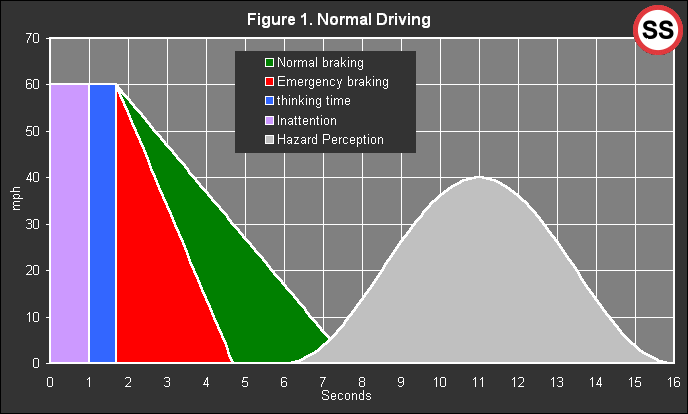
Notes to Figure 1.
Figure 1 illustrates an instant in time
on a 60 mph road. The driver is looking and planning ahead, ready to deal
with hazards that might appear to him in the grey hazard perception area.
(Naturally the hazard perception area is illustrative, and does not relate
to the mph scale.) Our driver knows that if anything appears to him in
the grey hazard perception zone, he will be able to stop before he reaches
it. He's even allowed for the possibility of a second of inattention, perhaps
a mirror check. He knows that there are no hazards closer than 6 seconds
and knows that if anything appears ahead he can stop in time. This is normal
driving.
Consider the two illustrated braking options.
The green area represents braking at 0.45g, which is about the max level
before things become uncomfortable for passengers. In normal driving we
shouldn't plan to exceed this level of braking. The red area represents
what can be achieved in an emergency. Our driver keeps the difference between
the two sorts of braking as a margin for error. At 60 mph the difference
is about 3 seconds, and if hazard perception doesn't work, or something
entirely unexpected happens emergency braking is available.
There are two areas which represent driver
inaction. The first pinkish area represents inattention and the blue area
represents thinking (or reaction) time.
Notice how long periods of inattention
would push the braking zones well into the hazard perception zone. This
is one of the main failures in driving, and it illustrates the situation
where you don't see something until it's too late. Even so it would
normally be possible to get some braking in before impact.
Remember we said this is an instant in
time? That's very important. Suppose there is a hazard in the grey zone.
It might not be serious enough to cause us to come to a full stop, but
it will cause us to adjust speed. Having adjusted speed we can then stop
in a shorter time, and at this new instant in time we are ready to deal
with closer hazards. To understand this better, let's look briefly at an
extreme example. It's a very busy situation, (imagine crowds of people,
with some of them in the road) and we've slowed to just 5 mph. The same
rules about safe braking zones apply, but now the distances involved are
much smaller. Although we've illustrated a 60 mph situation, exactly the
same shapes and layout apply to any speed. We always look ahead beyond
our safe braking zone, and adjust our speed if there's a risk of our safe
braking zone becoming obstructed. The speed adjustment can be all the way
down to stationary if the situation demands it.
The hazard recognition zone
It stands to reason that you can't first
see a road hazard 20 miles ahead, and it's obvious that recognising a road
hazard when it's 1 foot ahead would lead to an "instant accident" and is
a very rare occurrence indeed.
Between these extremes there's a range
where all hazards must be recognised. Almost all hazards almost all of
the time are recognised when they are far enough ahead that we can deal
with them safely and without drama.
It's important to consider the differences
between proper recognition and the failures that lead to accidents. |
| Inattention and accidents
People say something happened "suddenly"
and then the accident couldn't be avoided. In truth, very few things happen
suddenly on the road. Much more commonly, a driver with imperfect attention
will suddenly notice that something is going wrong. |
| Inattention and speed
Refer to the following graph. We have calculated
the equivalence between inattention and higher speed.
So, for example, a driver at 30 mph who
exhibits 1.5 seconds of inattention will come to rest at the same spot
in response to the same stimulus as a driver at almost 47 mph with no inattention.
We hope this demonstrates that driver inattention
has a dramatic effect on safety. Quite a few reports - including the RoSPA
report cited above - suggest that more than 2.5 seconds of inattention
is fairly commonplace - this can produce a similar effect to driving at
over 55 mph in a 30 mph zone.
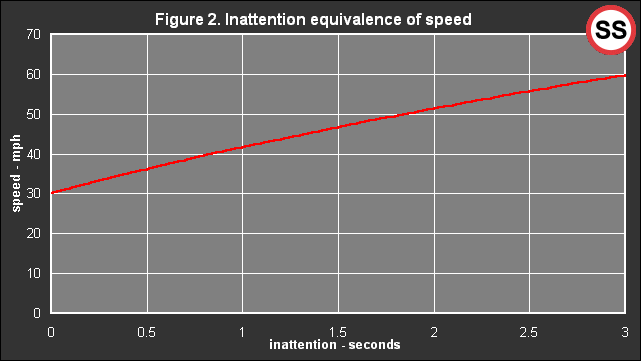
Take a few seconds to be sure to understand
the graph. We hear so much about the dangers of speed, yet all those claims
about the supposed dangers of going a few miles per hour faster are comprehensively
swamped by known and commonplace amounts of driver inattention.
You can download our "inattention / speed"
spreadsheet which calculated the above graph and vary parameters to see
the effects. (click here) |
| Inattention and hazard perception
If a driver is late recognising a road
hazard, for any reason, the effect is identical to inattention. The hazard
is approached without recognition or remedial action. It makes no difference
to the physics or the outcome if the driver is failing to look, failing
to think, failing to understand, failing to see or simply not paying attention.
All the comments, descriptions and conclusions on this page are equally
applicable to all the other listed types of driver failure. We've lumped
them together as "inattention" as a shorthand and because we're looking
at the effects. If we were looking at the causes, then each would need
to be dealt with separately. |
| Unavoidable inattention
Some things that you must do as a driver
require you to take your eyes off the road ahead. One example is using
the rear view mirror. So must you be at risk every time you use the mirror?
The answer is no, but the correct planning must be followed.
You need a margin for error at all
times
We recommend building a safety margin into
your driving by only planning to use the brakes gently. If something arises
within your margin, you have the option of using the brakes hard. It's
very simple and it always works. See (click here).
You only look in the mirror when
the situation ahead isn't developing rapidly
Obvious perhaps, but it makes a huge difference.
Managing unavoidable inattention
The very first thing we should all be doing
is leaving a 2 second gap from the vehicle ahead. Contrary to common misconception,
this gap has absolutely nothing to do with braking distance. We think of
it as 1 second for unavoidable inattention, and 1 second for reaction.
If you always have this gap, and nothing is developing ahead, you always
have time for a mirror check. (Braking distance is unimportant is because
the vehicle ahead has a similar braking distance to ours. The need is to
start braking no later in seconds than the original gap between the vehicles.) |
| Inattention and fatality
risk
Working from the rate of emergency braking,
and also from the change in speed in a crash (known as delta v) We observe
the relationships in the following graph. (Figure 3) (the fatality risk
calculations are based on the Joksch "rule of thumb" which is discussed
extensively (here))
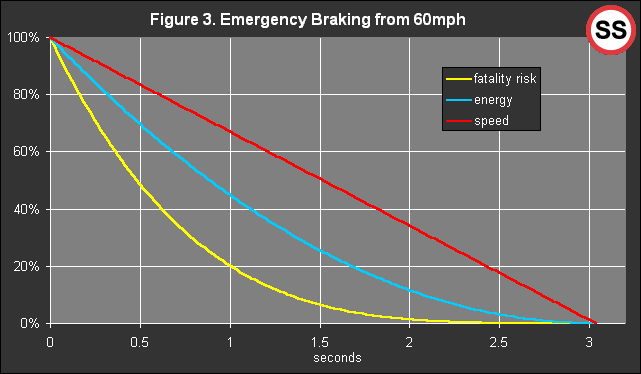
Notice how rapidly the potential fatality
risk falls once braking has started? After just half a second of braking
from 60 mph the risk of fatality is halved. If the driver had been inattentive
for just half a second, braking would not have started and the risk of
fatality would be doubled.
But 1.5 seconds of inattention is commonplace
(apparently). If that 1.5 seconds of inattention is combined with a need
to carry out emergency braking the calculated fatality risk increases by
15 times from 6.6% to 100% of the original value.
This effect is enormous. It should be obvious
that tiny changes in average driver attention would lead to quite large
changes in roads fatalities. |
| new
Inattention and general risk
In this section we present the effects
of inattention at 30 mph. We have used the following parameters: Inattention
2.5 seconds, speed 30 mph, thinking time 0.75 seconds, braking effort 0.9g.
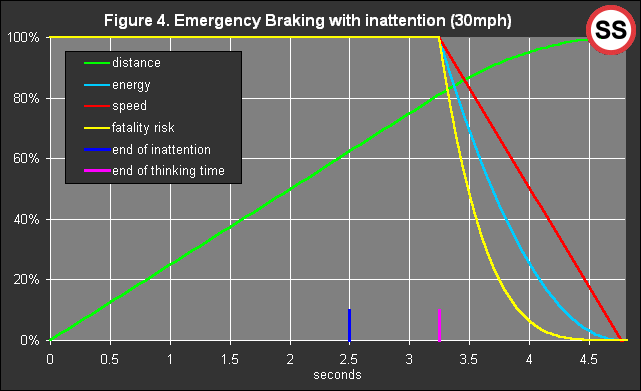
Figure 4 shows that 63% of the total distance
and 52% of the total time before coming to rest takes place while the driver
is inattentive, and over 81% of the distance is covered and 68% of the
total time before the driver reaches the brake. Notice how speed, kinetic
energy and fatality risk all remain at their maximum values during the
period before the brakes are operated. It follows that the highest dangers
are present during the period of inattention, with the risk of fatality
dropping by 50% in the first 0.25 seconds once braking actually starts.
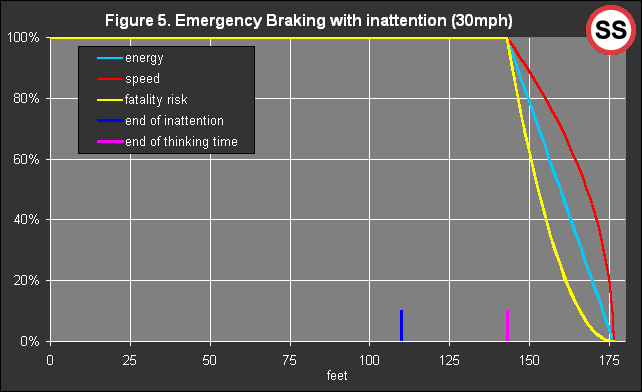
Figure 5 is similar to figure 4 except
that the horizontal scale is in distance rather than time. Both views are
important, and the second appears to make our point more strongly.
However, we recommend Figure 4 as the more
driver oriented view. We prefer the driver oriented view because it is
the driver who made the mistake - if these sorts of dangerous mistakes
are to be addressed, it's the driver who must be attending to.
We hope it's clear from these two graphs
that inattention can be extremely dangerous. In fact, we would fully support
a government information campaign based around the catch phrase: "Inattention
kills". |
| new
Inattention - how bad is it out there?
Actually it's pretty good - we might have
inattentive drivers, but don't forget we already have the safest roads
in the world - so they can't be that inattentive most of the time.
We also know with certainty that the vast
majority of accidents are mitigated by driver response, and logically we
can't have a successful driver response without adequate attention. The
following Safe Speed pages illustrate how driver responses mitigate accident
effects in the real world:
(Killspeed),
(ThatAd) and (Proof):
Safe Speed pages examining the risks in pedestrian collisions.
(12mph) and (Percentages):
Safe Speed pages examining the risks facing drivers
(Ten): A Safe Speed
page showing how accident risks vary not with speed, but with degree
of error.
There's no room for doubt about the evidence
presented on those pages - Most of the time most drivers in most situations
are effective at reducing the impact of accidents, but more importantly
they avoid accidents altogether for years on end. These behaviours are
largely the result of adequate driver attention.
But, on the other hand, we also know that
a large number of accidents have their root cause in driver attention failings,
and we should therefore deduce that any change in average driver attention
should soon be reflected in the national accident statistics. So how might
we alter average driver attention? |
new
Factors affecting average attention - improving inattention
Workload - getting
worse
For any activity there's an optimal workload
- too much work and we can't keep up - too little and we get bored. As
we drive faster so the workload increases. At some point we'd reach overload
and start to perform badly. But drivers have control of speed and naturally
choose to vary speed to achieve a reasonable workload in the optimal range.
If we slow them down in a misguided attempt to reduce accidents, we risk
taking their workload out of the optimal range and actually promoting inattention
and even sleepiness. The modern trend is in the wrong direction.
Distraction - getting
worse
Plenty of real world driver inattention
is caused by distraction from the important tasks of driving. Distractions
might come from passengers, telephone calls, roadside billboards (to name
a few) or they might come from internal causes such as the driver worrying
about the usual things: job, relationships, money etc. If we ask drivers
to pay extra attention to something - anything - it should be obvious that
less attention will remain for the most important and immediate tasks of
driving. We believe that the modern need to pay great attention to speed
limit, numerical speed and the risk of speed enforcement is in itself an
important and significant modern distraction to the road ahead. See our
(effects) page. The modern trend is in the wrong
direction.
Concentration as a skill + Experience
- not changing
We can deduce from the RoSPA figures quoted
above that improved concentration is learned as drivers gain experience.
That's another way of saying that experienced drivers have fewer bouts
of inattention. Yet we do little or nothing to help drivers to learn quickly
as they gain experience. We don't offer national additional driver training
where an instructor could point out lapses in attention and we don't even
have public information films explaining how inattention manifests itself.
It would be so easy to explain that when things appear to happen suddenly
on the road that the most common root cause is that the drivers wasn't
concentrating properly and noticed it late. There is no current trend
change - but there could be...
Safety Culture - getting
worse
We've earned the safest roads in the world
by having the best safety culture. If we feed the national safety culture
we will help to give drivers the very best priorities and in so doing will
help them to concentrate better on the things that matter the most. It
follows that we must ensure we understand what the safety culture is and
where it comes from - then we must nurture and develop it. Average inattention
will reduce as an inevitable consequence. See (road
safety). The modern trend is in the wrong direction. |
| Modelling the effects of
inattention
We're working on a number of different
models exploring the effects of inattention. When anything is finished
and verified, we'll add it to this page. Meanwhile, if any mathematically
inclined visitors are interested in collaboration on this further investigation,
please get in touch. (email) |
| Conclusions
One second of inattention...
...is worth 20 mph. But safety improves
remarkably quickly once braking has started.
In 2.5 seconds...
... you can reduce speed by about 50 mph
if necessary. RoSPA tells us that 2.5 seconds of inattention is fairly
commonplace.
Crash preparedness
When an accident risk occurs on the road
at some instant an involved driver will recognise the risk. If full and
complete attention is being paid then almost all risks will be recognised
while they are still outside of the drivers safe braking zone.
The worse the driver's attention at the
time the more likely the danger is to come within the driver's safe braking
zone.
A very bad thing about inattention is that
during the period of inattention the potential crash energy remains at
maximum.
Sensitivity of safety to inattention
Overall road safety is very sensitive is
to average driver inattention. We can't hope to eliminate inattention,
but if we communicate its huge importance to drivers we can hope to make
a real difference.
Moving backwards
Modern roads policing by speed camera does
nothing to promote driver attention. Instead it tends to distract drivers
from the road ahead and instead requires them to pay more attention to
low safety priorities like numerical speed, speed limit, speed limit compliance
and the risk of speed enforcement. In this way we're moving road safety
backwards, and clearly should not be surprised to see bad trends in the
figures. |
| new
Comments
Safe Speed encourages comments, further
information and participation from our visitors. See our (forums).
Read about our comments policy (here).
Many pages (including this one) have a
specific associated forum topic. You can (view)
or (add
comment) to the forum topic for this page. Posting in the forum requires
simple registration. |





